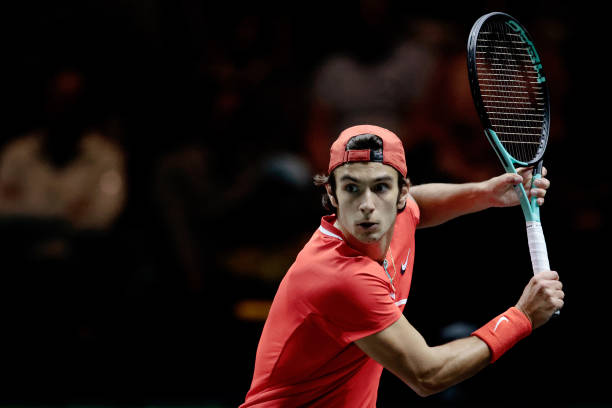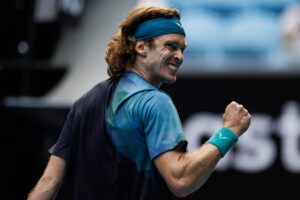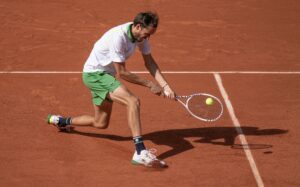In the continuing absence of Roger Federer from the ATP Tour, tennis purists have had to look elsewhere for their stylistic kicks and in particular for a new favourite stroke to match the fluidity and grace of either Federer’s forehand or backhand. It is possible that many of them may eventually settle on the lovely single-handed backhand of Lorenzo Musetti, a stroke that the young Italian hits with such ease and power that it evokes memories of the finest single-handed backhands ever seen in men’s tennis, including those of Federer, Stan Wawrinka and John McEnroe. However, even as Musetti continues to rise up the world rankings, it must be asked whether a single-handed backhand will ever be enough again to challenge at the very top of men’s tennis.
The single-handed backhand has always been the tennis aesthete’s favourite stroke and regarded by them as infinitely more pleasing to the eye than the double-hander. The double-handed backhand inevitably creates a sensation of effort and control; it is a very conscious shot, as it were, which is only made to appear remotely natural by years of practice and fine tuning. By contrast, the single-handed backhand, when played well, creates the opposite impression, namely of ease, comfort and even naturalness. At its absolute best, it can be played more quickly and instinctively than the two-hander, simply because it does not require a player to grip the racket with both hands to generate power.
One major reason for the popularity of the single-handed backhand among tennis stylists is that it was the backhand of choice of three truly great players who might be regarded as The Holy Trinity of Artistic Tennis: Nicola Pietrangeli, the two-time French Open winner (1959 and 1960), whose legendary flair was rediscovered by a later generation because of its similarity to that of Federer; John McEnroe, the seven-time Major winner (four US Opens and three Wimbledons), who, before Rafael Nadal came along, was widely regarded as the greatest left-hander to play tennis; and, of course, Federer, the 20-time Major winner, whose precise and even poetic expression on both wings has captivated millions of tennis fans around the world for the last 20 years. The fact that these three great players, who embodied the idea of tennis creativity rather than tennis strength, all played with a single-handed backhand only confirmed what already appeared to be the inherent superiority of the single-hander to the comparatively ungainly, even ugly, two-hander.
Given that most tennis players, either male or female, have had a two-handed backhand ever since it became the dominant type of backhand from the early 1970s onwards, the single-handed backhand has always had rarity value in the Open Era (since 1968, when tennis went fully professional). Consequently, whenever two single-handers meet, especially if they are male, it is noteworthy. That was the case in the Final of the ATP Tour Finals in 2019, when Dominic Thiem met Stefanos Tsitsipas and the Austrian said before the match that it would be a treat for the tennis purist. It certainly was, but that was the last significant match-up, in a Major Men’s Final or Tour Finals Final, between two single-handed backhands and it is increasingly difficult to imagine when the next one will be.
That is because the single-handed backhand is coming under increasing threat from the double-hander. At the very highest level of the men’s game, that has been evident over the last 15 years, or the era of “The Big Three”. Arguably, the single biggest deficiency, or at least relative deficiency, in Roger Federer’s otherwise outstanding all-court game was the fact that his single-handed backhand just could not generate the same power as the double-handers of both Rafael Nadal and Novak Djokovic. That was especially evident on the high-bouncing clay of Paris, where Nadal’s forehand, when it was played into Federer’s backhand, often leapt off the court to such an extent that Federer found it almost impossible to return the ball, let alone return it with interest.
Of course, prior to Federer’s remarkable late-career renaissance, when he returned triumphantly in January 2017 to win three of the next four Majors that he played, the great Swiss had spent much of the previous six months (the second half of the 2016 season) recovering from injury and determinedly remodelling his backhand to cope with the extra power and aggression of Nadal’s double-hander. In the short term, it undoubtedly worked, particularly in the classic 2017 Australian Open Final between the two men, when Federer finally defeated Nadal in a Major Final for the first time in nearly 10 years. In the long run, however, it is surely indisputable that Nadal and Djokovic’s double-handed backhands have ultimately seen off the single-handed Federer backhand, although the injuries that Federer has suffered at the end of his career have also contributed to what must now be regarded as a terminal decline.
A similar pattern, with the double-handed backhand dominating the single-hander, has been emerging in all of men’s tennis and not just within the Big Three. At last month’s Australian Open semifinals, for example, Daniil Medvedev won relatively easily against Stefanos Tsitsipas. Indeed, such was the domination that Tsitsipas, like all players with a single-handed backhand, must have been left wondering what he has to do to compete with such monstrous two-handed backhands. It is too late in his own career to even to consider switching to a single-handed backhand, but much younger players might just wonder whether it is worth trying to.
Among those younger players, of course, is Lorenzo Musetti, who now possesses what is surely the most sumptuous single-handed backhand in men’s tennis. That was evident last year in his breakthrough tournament, the French Open, when he produced a seemingly endless succession of stunning backhands to advance to the fourth round, where he even took a two-set lead against the Calendar Slam-hunting Djokovic before the Serb fought back with such intensity that the young Italian was forced to retire injured in the fifth set.
After that spectacular display on his Major debut, Musetti, perhaps unsurprisingly, suffered a major comedown, one that seemed to last for almost the entire second half of last season. Consequently, it was wonderful to see him returning to form in Rotterdam last week, when he reached the quarter-finals by beating Sweden’s Mikael Ymer (another of the game’s rising stars) and Hubert Hurkacz, the world no.11, who was ranked inside the top 10 at the end of last year. In both those wins, and particularly against Hurkacz, the Musetti single-handed backhand was the most rapid of rapiers, striking winners down the line and cross-court seemingly while the opponent was still taking a grip of his racket with both hands.
Unfortunately for Musetti and his growing band of admirers, he lost in the Rotterdam semi-final to another young star who spectacularly announced his presence on the ATP Tour, Jiri Lehecka of the Czech Republic. At 20, Lehecka may be only a year older than Musetti, but he looked a lot stronger, including on the backhand wing, as he eventually won a hard-fought match in three sets. Having beaten Denis Shapovalov and Musetti in the same week, Lehecka already looks like he is another product of the great Czech tradition of tennis, who could yet follow in the illustrious footsteps of Jaroslav Drobný, Martina Navratilova, Ivan Lendl, Barbora Krejčíková et al.
In addition, Lehecka could join the growing band of young male stars with powerful double-handed backhands who could rise above Musetti and his single-hander to challenge for Majors in the future. Both the precocious Carlos Alcaraz and Musetti’s compatriot Jannik Sinner, who are probably the two brightest young stars in men’s tennis, have double-handed backhands and at this stage it is impossible not to fear that Musetti will have enormous problems in getting past any or indeed all of them if he is ever to win a Major. And if Musetti cannot win a Major with his cannon of a single-hander, then perhaps no-one with a single-hander can.
Thus it might be that in another generation or two, the single-handed backhand will ultimately become as obsolete as the two-handed forehand, which at one point in the early evolution of tennis was the dominant form of forehand. That might be inevitable, but if it happens it would still be a shame, as another part of the unique DNA of artistic, truly aesthetic tennis would be lost forever.
Main Photo:






